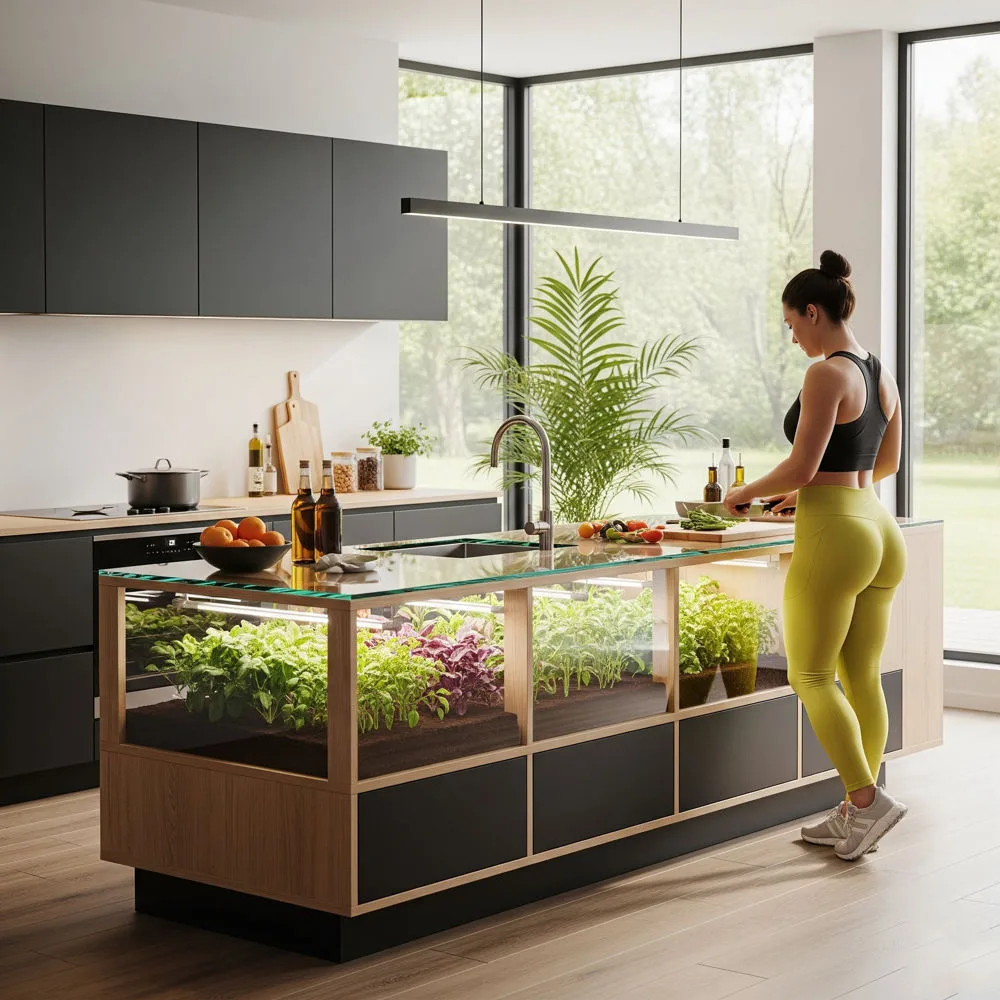The modern kitchen has evolved far beyond its traditional role as a simple cooking space. Today’s homeowners are embracing innovative designs that combine functionality with sustainability, and nothing exemplifies this trend better than kitchen islands with built-in hydroponic gardens. These revolutionary fixtures transform your kitchen into a living ecosystem where fresh herbs, vegetables, and greens grow right at your fingertips, creating an unprecedented fusion of culinary convenience and agricultural innovation.
Imagine preparing a gourmet meal while harvesting fresh basil from your kitchen island, or garnishing your morning smoothie with lettuce picked seconds before consumption. This isn’t science fiction anymore – it’s the reality of modern smart home design. Kitchen islands with built-in hydroponic gardens represent the pinnacle of sustainable living, offering homeowners the opportunity to grow their own produce year-round, regardless of climate or outdoor space limitations.
What Are Kitchen Islands With Built-in Hydroponic Gardens?

Understanding the Concept
Kitchen islands with built-in hydroponic gardens are specially designed kitchen fixtures that incorporate soilless growing systems directly into the island structure. These innovative installations feature integrated water reservoirs, nutrient delivery systems, LED grow lights, and climate control mechanisms that create optimal growing conditions for various plants. The hydroponic system operates independently of traditional soil-based gardening, using nutrient-rich water solutions to feed plants directly through their root systems.
The design typically includes multiple growing chambers or towers built into the island’s structure, allowing for vertical growing that maximizes space efficiency. Advanced models feature automated systems that monitor pH levels, nutrient concentrations, and lighting schedules, making it possible for even novice gardeners to achieve professional results.
Key Components and Features
The most sophisticated kitchen islands with built-in hydroponic gardens include several essential components that work together to create a thriving growing environment. The foundation consists of a water circulation system that continuously delivers nutrients to plant roots while maintaining optimal oxygenation. LED grow lights provide the full spectrum of light necessary for photosynthesis, often programmable to simulate natural day and night cycles.
Temperature and humidity controls ensure consistent growing conditions, while integrated sensors monitor water levels, nutrient concentrations, and environmental factors. Many systems also include smartphone connectivity, allowing homeowners to monitor and control their gardens remotely through dedicated mobile applications.
Benefits of Integrating Hydroponic Systems Into Kitchen Islands
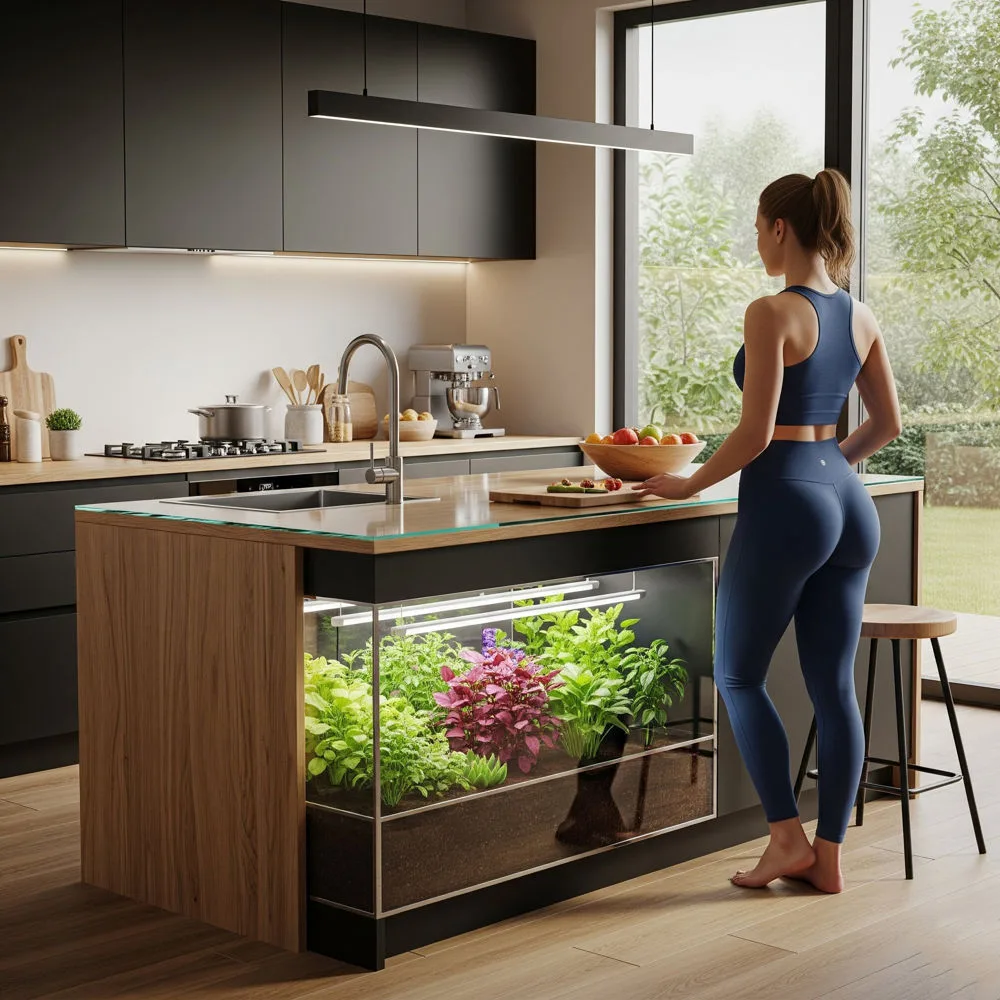
Fresh Produce at Your Fingertips
The primary advantage of kitchen islands with built-in hydroponic gardens is the unprecedented access to fresh, homegrown produce. Traditional gardening requires outdoor space, favorable weather conditions, and seasonal timing, but hydroponic kitchen islands eliminate these constraints entirely. You can harvest fresh herbs for your pasta sauce, crisp lettuce for your salad, or aromatic basil for your pizza at any time of year, ensuring maximum flavor and nutritional value in every meal.
The proximity factor cannot be overstated – having your garden integrated into your primary food preparation area means zero transportation time from harvest to plate. This immediacy preserves the peak nutritional content of your produce while ensuring optimal flavor profiles that simply cannot be achieved with store-bought alternatives.
Space Optimization and Aesthetic Appeal
Kitchen islands with built-in hydroponic gardens serve dual purposes, maximizing both functionality and visual appeal within your kitchen space. Instead of dedicating separate areas for gardening and food preparation, these integrated systems combine both functions into a single, elegant fixture. The vertical growing design inherent in most hydroponic systems allows for substantial plant capacity within a relatively compact footprint.
From an aesthetic perspective, these living islands create stunning focal points that bring natural beauty into your kitchen environment. The vibrant greens of growing plants, combined with the sophisticated technology of modern hydroponic systems, create a striking contrast that elevates the entire kitchen design. Many homeowners find that their hydroponic kitchen islands become conversation pieces that impress guests while serving practical daily functions.
Sustainable Living and Environmental Benefits
Kitchen islands with built-in hydroponic gardens represent a significant step toward sustainable living practices. Hydroponic systems use up to 95% less water than traditional soil-based gardening, making them incredibly efficient in terms of resource consumption. The controlled environment eliminates the need for pesticides, herbicides, and other chemicals commonly used in conventional agriculture, ensuring that your produce is completely organic and free from harmful residues.
The local production aspect reduces your carbon footprint by eliminating transportation requirements associated with store-bought produce. Additionally, the year-round growing capability means you can maintain a consistent supply of fresh vegetables and herbs regardless of seasonal availability, reducing dependence on imported produce that may have traveled thousands of miles to reach your local grocery store.
Design Considerations and Installation Requirements
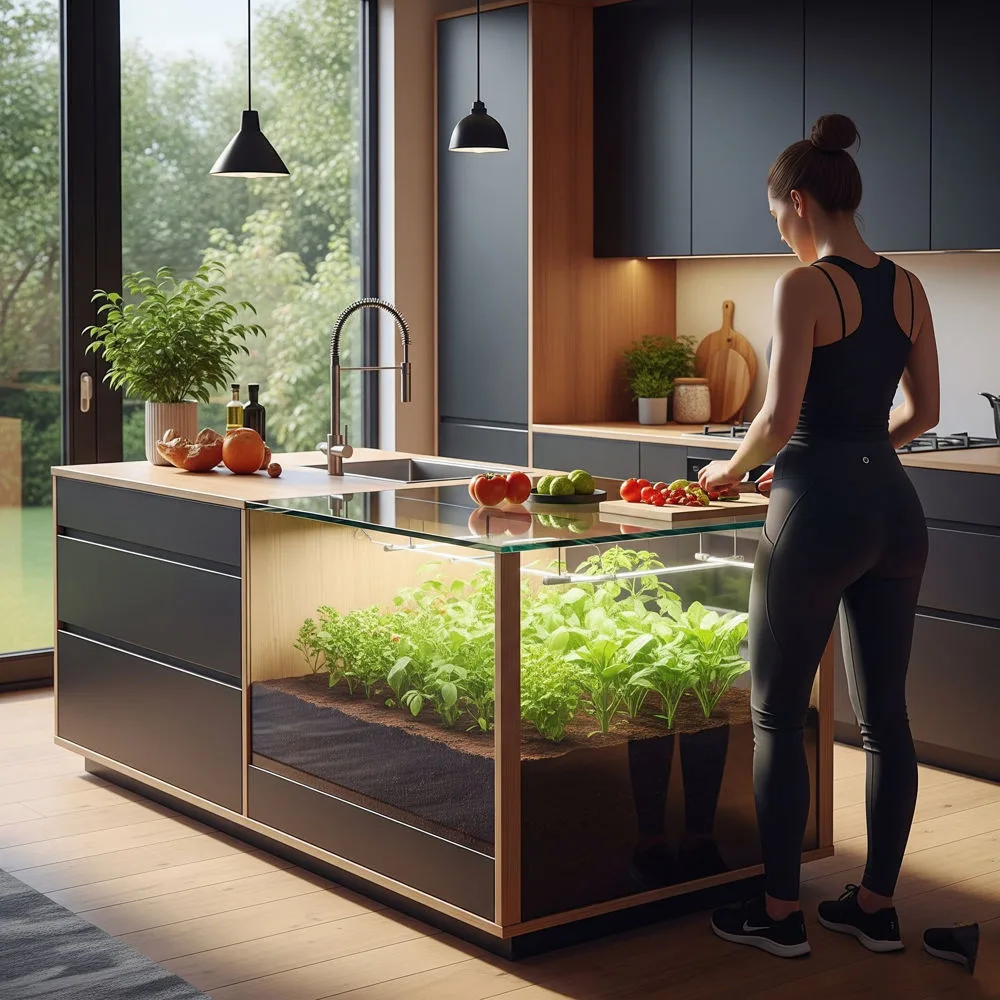
Structural Planning and Space Requirements
Installing kitchen islands with built-in hydroponic gardens requires careful planning and consideration of various structural factors. The island must be designed to accommodate the weight of water reservoirs, growing systems, and mature plants, which can be substantial when fully operational. Professional structural assessment is often necessary to ensure that existing flooring and support systems can handle the additional load.
Adequate space planning is crucial for both the hydroponic system and surrounding kitchen functionality. The island should provide sufficient clearance for accessing growing chambers, maintenance activities, and normal kitchen operations. Consider the mature size of plants you intend to grow, as some varieties may require more vertical space than others.
Electrical and Plumbing Considerations
Kitchen islands with built-in hydroponic gardens require specialized electrical and plumbing infrastructure to operate effectively. The electrical system must accommodate LED grow lights, water pumps, climate control systems, and monitoring equipment, often requiring dedicated circuits to handle the power load safely. Professional electrical installation ensures that all components meet safety codes and operate efficiently.
Plumbing considerations include both water supply and drainage systems. While hydroponic systems recirculate water efficiently, they still require periodic water changes and system maintenance. Some installations include direct water line connections for automated refilling, while others rely on manual water management. Proper drainage is essential for maintenance activities and emergency overflow protection.
Ventilation and Climate Control
Effective ventilation is critical for successful kitchen islands with built-in hydroponic gardens. The growing environment generates humidity and heat from LED lights, which must be managed to prevent condensation and maintain optimal growing conditions. Integrated ventilation systems often include humidity controls, air circulation fans, and temperature regulation to create stable microclimates within the growing chambers.
The ventilation system must also prevent the hydroponic garden from affecting the overall kitchen environment. Proper air circulation prevents excessive humidity from impacting other kitchen functions while ensuring that growing plants receive adequate fresh air circulation for healthy development.
Best Plants for Kitchen Island Hydroponic Gardens
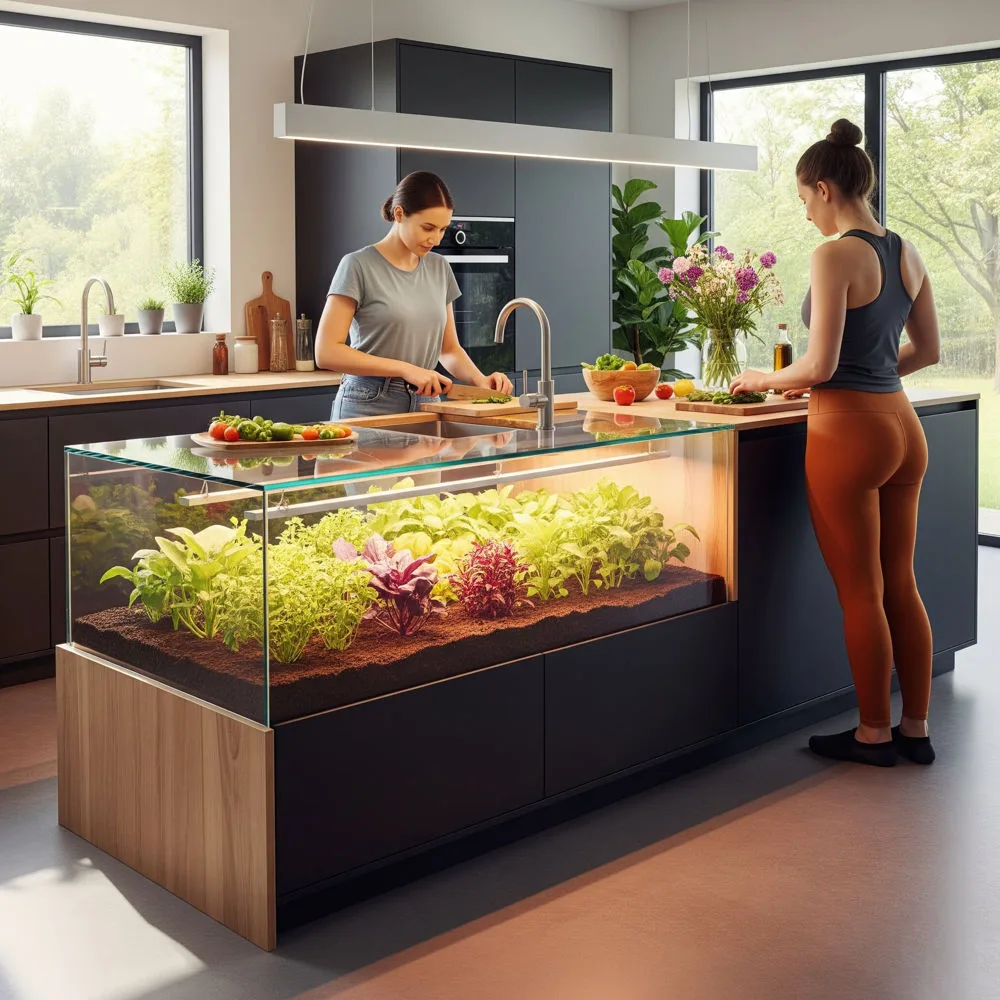
Herbs and Aromatics
Kitchen islands with built-in hydroponic gardens are particularly well-suited for growing culinary herbs and aromatic plants. Basil varieties thrive in hydroponic systems, producing abundant, flavorful leaves that are essential for Mediterranean cuisine. Cilantro, parsley, chives, and oregano also perform exceptionally well, providing fresh herbs that significantly enhance the flavor profiles of your cooking.
Aromatic herbs like rosemary, thyme, and sage can be grown successfully in hydroponic systems, though they may require slightly different nutrient formulations than leafy herbs. The controlled environment allows for consistent production of these valuable culinary ingredients, ensuring that you always have fresh herbs available for your favorite recipes.
Leafy Greens and Microgreens
Leafy greens represent another excellent category for kitchen islands with built-in hydroponic gardens. Lettuce varieties, spinach, kale, and arugula grow quickly and produce high yields in hydroponic systems. These plants have relatively compact growth habits that make them ideal for kitchen island installations where space efficiency is important.
Microgreens offer particularly attractive options for hydroponic kitchen gardens. These nutrient-dense seedlings can be harvested within days of planting, providing continuous production of fresh garnishes and salad ingredients. Popular microgreen varieties include pea shoots, sunflower greens, and radish sprouts, all of which add distinctive flavors and textures to your culinary creations.
Compact Vegetables and Specialty Crops
While larger vegetables may not be practical for most kitchen islands with built-in hydroponic gardens, certain compact varieties can be successfully grown in these systems. Cherry tomatoes, small peppers, and dwarf cucumber varieties can thrive in hydroponic environments, providing fresh vegetables for daily consumption.
Specialty crops like edible flowers, exotic herbs, and unique vegetable varieties become accessible through hydroponic cultivation. These plants, which might be expensive or difficult to find in traditional grocery stores, can be grown successfully in your kitchen island system, expanding your culinary possibilities significantly.
Technology and Automation Features
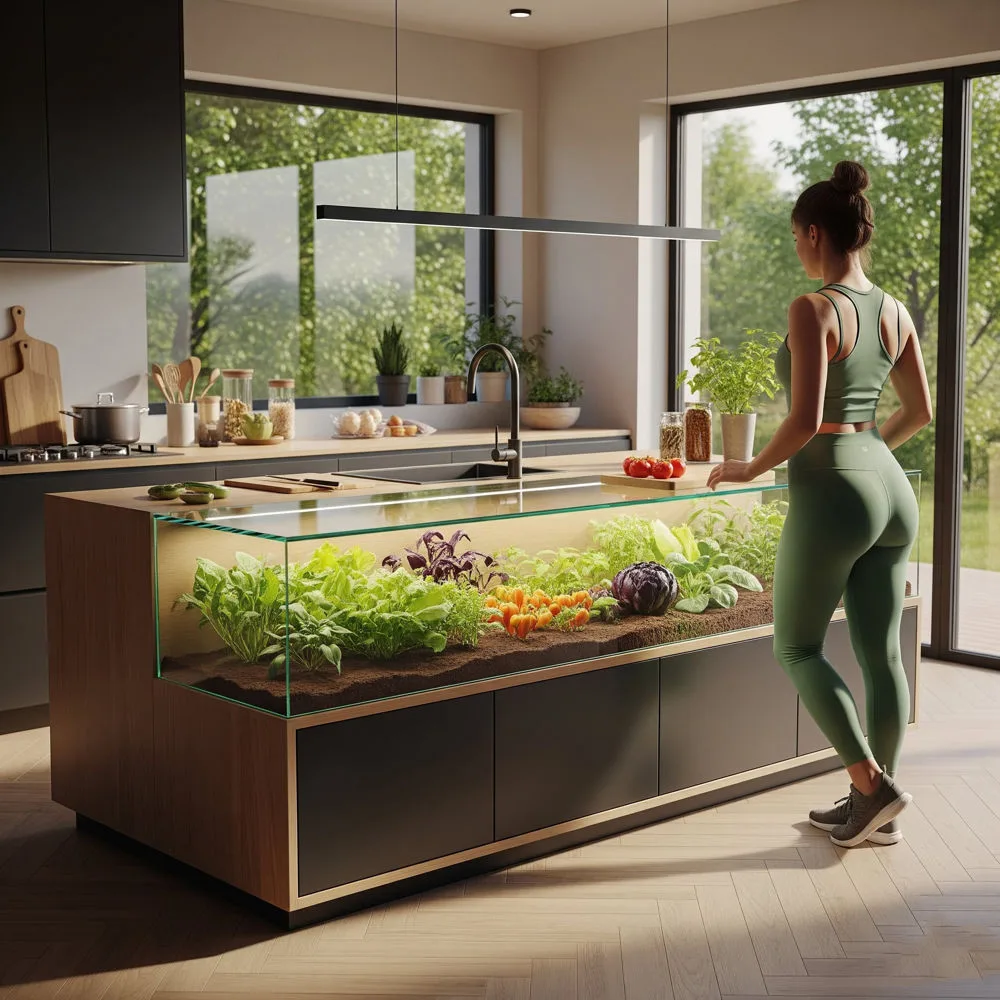
Smart Monitoring Systems
Modern kitchen islands with built-in hydroponic gardens incorporate sophisticated monitoring technologies that automate many aspects of plant care. pH sensors continuously monitor water acidity levels, automatically adjusting nutrient solutions to maintain optimal growing conditions. Water level sensors prevent system failures by alerting homeowners when reservoirs need refilling or when potential leaks occur.
Nutrient monitoring systems track the concentration of essential plant nutrients, ensuring that plants receive proper nutrition throughout their growth cycles. These systems can automatically adjust nutrient delivery or alert users when manual intervention is required, making hydroponic gardening accessible to people with limited gardening experience.
Automated Lighting and Climate Control
LED grow light systems in kitchen islands with built-in hydroponic gardens feature programmable timers and intensity controls that simulate natural growing conditions. Advanced systems can adjust light spectrums throughout the day, providing blue light for vegetative growth and red light for flowering and fruiting phases. Some models include seasonal programming that automatically adjusts lighting schedules based on the time of year.
Climate control automation manages temperature, humidity, and air circulation within the growing environment. These systems can respond to external conditions, adjusting internal environments to maintain optimal growing conditions regardless of kitchen temperature or humidity fluctuations.
Mobile App Integration and Remote Management
Many kitchen islands with built-in hydroponic gardens include smartphone connectivity that allows remote monitoring and control of growing systems. Mobile applications provide real-time data on plant health, environmental conditions, and system status, enabling homeowners to manage their gardens from anywhere in the world.
These apps often include growing guides, harvest schedules, and troubleshooting assistance, making hydroponic gardening more accessible to beginners. Some systems can even send notifications when plants are ready for harvest or when maintenance activities are required.
Maintenance and Care Requirements
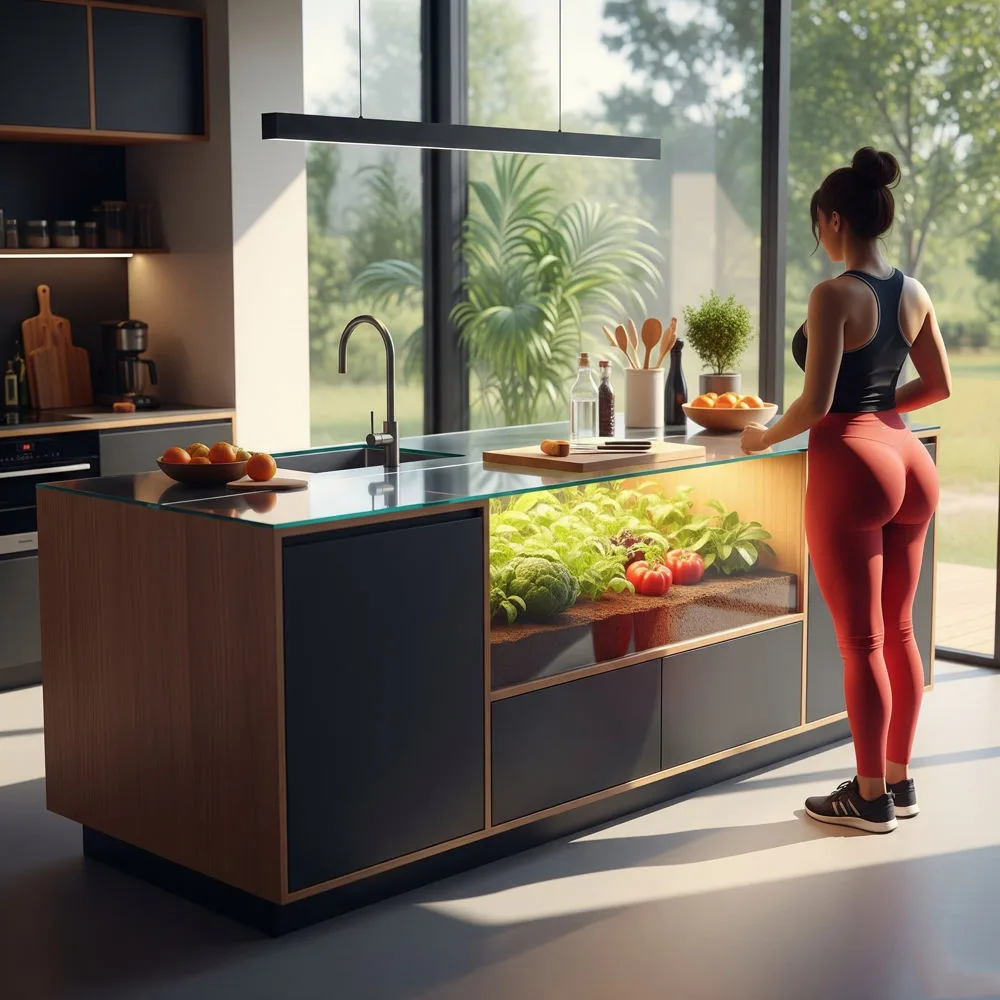
Daily and Weekly Maintenance Tasks
Kitchen islands with built-in hydroponic gardens require regular maintenance to ensure optimal performance and plant health. Daily tasks typically include visual inspection of plants, checking water levels, and monitoring environmental conditions through integrated display systems. Weekly maintenance involves more detailed system checks, including cleaning of growing chambers and inspection of root systems for signs of disease or nutrient deficiency.
Water quality management is crucial for successful hydroponic gardening. Regular testing and adjustment of pH levels, nutrient concentrations, and water temperature ensure that plants receive optimal growing conditions. Many automated systems minimize these requirements, but periodic manual verification remains important for long-term success.
Seasonal Maintenance and System Upgrades
Kitchen islands with built-in hydroponic gardens benefit from seasonal maintenance routines that ensure long-term system reliability. Deep cleaning of water reservoirs, replacement of growing media, and comprehensive system inspections help prevent problems before they affect plant health. Filter replacements, pump maintenance, and LED light performance checks should be performed according to manufacturer recommendations.
System upgrades may include software updates for smart monitoring systems, replacement of worn components, and integration of new technologies as they become available. Regular maintenance extends the lifespan of your hydroponic system while ensuring consistent performance and plant production.
Cost Analysis and Investment Considerations
Initial Investment and Installation Costs
Kitchen islands with built-in hydroponic gardens represent a significant initial investment that varies widely based on system complexity and customization requirements. Basic systems may start around $5,000, while fully automated, custom-designed installations can exceed $20,000 or more. Installation costs include professional electrical and plumbing work, structural modifications, and system setup and calibration.
The investment should be evaluated based on long-term benefits, including reduced grocery costs, improved food quality, and enhanced property value. Many homeowners find that the convenience and satisfaction of growing their own produce justify the initial expense, particularly when considering the ongoing costs of purchasing organic herbs and vegetables.
Operating Costs and Long-Term Savings
Operating costs for kitchen islands with built-in hydroponic gardens include electricity for lighting and pumps, nutrients and growing supplies, and periodic maintenance expenses. While LED grow lights are energy-efficient, continuous operation does result in increased electricity consumption. However, many users find that the cost savings from reduced grocery purchases offset these operating expenses.
Long-term savings can be substantial, particularly for households that regularly purchase organic produce. The ability to grow expensive herbs and specialty vegetables can result in significant monthly savings, while the improved quality and freshness of homegrown produce provide additional value that is difficult to quantify financially.
Future Trends and Innovations
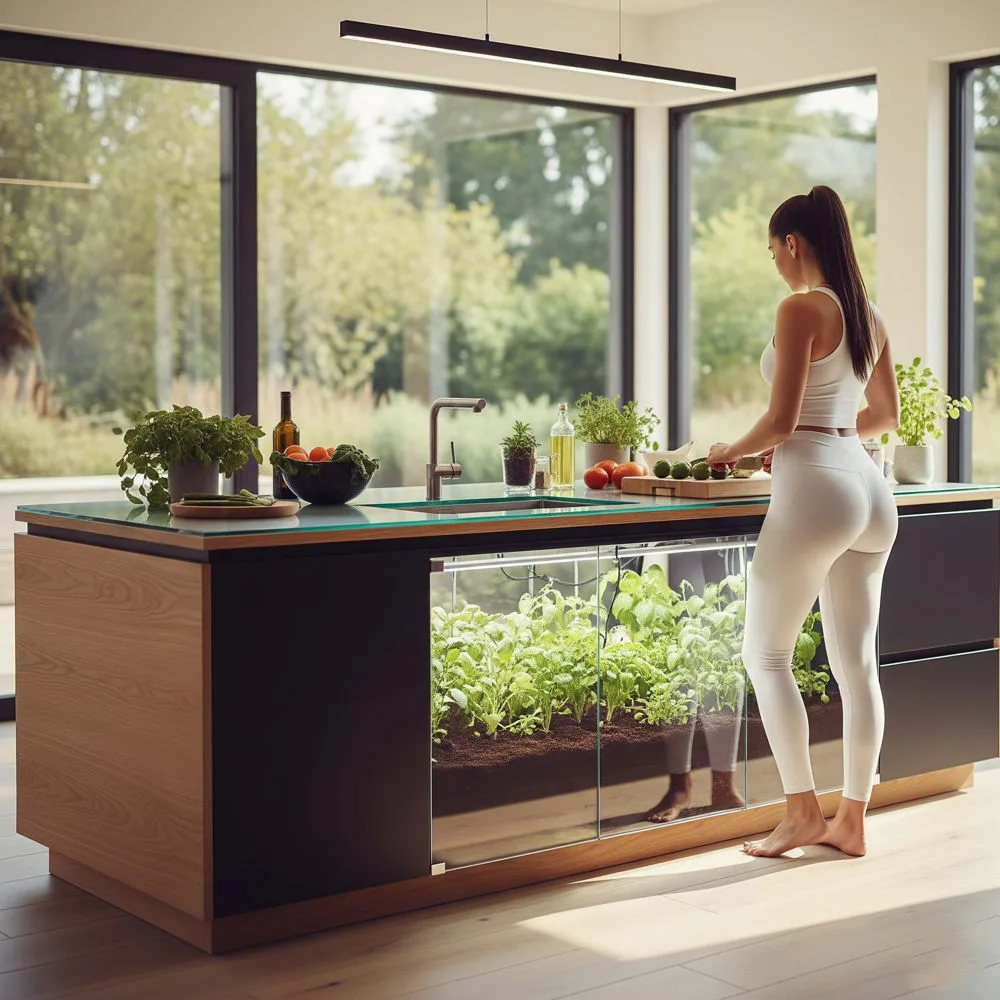
Emerging Technologies and Design Trends
The field of kitchen islands with built-in hydroponic gardens continues to evolve rapidly, with new technologies and design innovations emerging regularly. Artificial intelligence integration promises to optimize growing conditions automatically, learning from plant responses and environmental factors to maximize yields and minimize resource consumption. Advanced sensor technologies will provide even more precise monitoring and control capabilities.
Design trends are moving toward more integrated and aesthetically pleasing installations that blend seamlessly with kitchen decor. Modular systems that can be easily reconfigured or expanded are becoming popular, allowing homeowners to adapt their growing capacity based on changing needs and preferences.
Integration with Smart Home Systems
Future kitchen islands with built-in hydroponic gardens will likely integrate more seamlessly with comprehensive smart home systems. Voice control capabilities, integration with home automation platforms, and coordination with other smart appliances will create more intuitive and user-friendly experiences. Predictive analytics may eventually enable systems to anticipate harvest schedules and automatically adjust growing plans based on household consumption patterns.
The convergence of kitchen technology and hydroponic systems will continue to blur the lines between cooking and gardening, creating more holistic approaches to food preparation and consumption. These integrated systems will make sustainable living more accessible and appealing to mainstream consumers.
Conclusion
Kitchen islands with built-in hydroponic gardens represent a revolutionary approach to modern kitchen design that addresses multiple contemporary concerns: sustainability, food security, health consciousness, and technological innovation. These sophisticated systems transform the traditional kitchen into a living ecosystem where fresh produce grows alongside meal preparation, creating an unprecedented integration of agriculture and culinary arts.
The benefits of installing kitchen islands with built-in hydroponic gardens extend far beyond simple convenience. They offer homeowners the opportunity to take control of their food production, ensuring access to fresh, organic produce year-round while reducing environmental impact through local production and resource efficiency. The integration of advanced technologies makes these systems accessible to gardeners of all skill levels, while the aesthetic appeal enhances the overall kitchen environment.
As technology continues to advance and consumer awareness of sustainability issues grows, kitchen islands with built-in hydroponic gardens are positioned to become standard features in modern homes. The initial investment is offset by long-term savings, improved food quality, and the satisfaction of growing your own produce. For homeowners seeking to create truly innovative and sustainable kitchens, these integrated growing systems offer an compelling solution that combines cutting-edge technology with timeless agricultural principles.
The future of kitchen design is here, and it’s growing right in your kitchen island. Whether you’re a culinary enthusiast, sustainability advocate, or technology lover, kitchen islands with built-in hydroponic gardens offer a unique opportunity to transform your cooking space into a productive, beautiful, and environmentally responsible hub of your home. The investment in this technology is an investment in a more sustainable, healthy, and enjoyable approach to daily living that will benefit your family for years to come.

